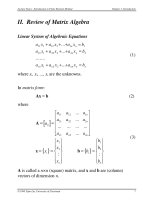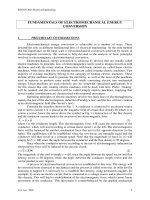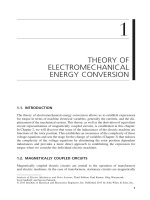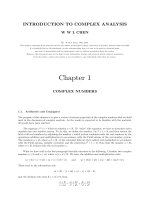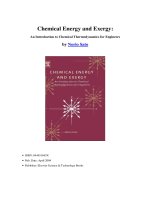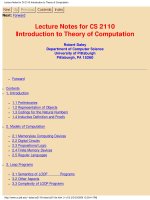Lecture Electromechanical energy conversion: Introduction to Rotating machines - Nguyễn Công Phương
Bạn đang xem bản rút gọn của tài liệu. Xem và tải ngay bản đầy đủ của tài liệu tại đây (820.56 KB, 78 trang )
Nguyễn Công Phương
ELECTROMECHANICAL ENERGY
CONVERSION
Introduction to Rotating Machines
Contents
I. Magnetic Circuits and Magnetic Materials
II. Electromechanical Energy Conversion
Principles
III.Introduction to Rotating Machines
IV. Synchronous Machines
V. Polyphase Induction Machines
VI. DC Machines
VII.Variable – Reluctance Machines and Stepping
Motors
VIII.Single and Two – Phase Motors
IX. Speed and Torque Control
sites.google.com/site/ncpdhbkhn
2
Introduction to Rotating
Machines
1. Elementary Concepts
2. Introduction to AC and DC Machines
3. MMF of Distributed Windings
4. Magnetic Fields in Rotating Machinery
5. Rotating MMF Waves in AC Machines
6. Generated Voltage
7. Torque in Nonsalient – Pole Machines
8. Linear Machines
9. Magnetic Saturation
10.Leakage Fluxes
sites.google.com/site/ncpdhbkhn
3
Elementary Concepts (1)
• In rotating machines, voltage are generated in windings
or groups of coils by rotating these windings
mechanically through a magnetic field:
– By mechanically rotating a magnetic field past the winding,
or
– By designing the magnetic circuit so that the reluctance
varies with rotation of the rotor.
• A set of such coils connected together is typically
referred to as an armature winding.
• In AC machines (e.g. synchronous or induction), the
armature winding is typically on the stationary –
portion of the motor (referred to as the stator).
• In DC machines, the armature winding is on the
rotating portion of the motor (referred to as the rotor).
sites.google.com/site/ncpdhbkhn
4
Elementary Concepts (2)
• Second winding(s) carrying DC currents and used
to produce the main operating flux in the machine
is called field winding
– For a DC machine, it is on the stator.
– For a synchonous machine, it is on the rotor.
– Sometimes it is a permanent magnet.
• The time – varying flux tends to induce currents,
known as eddy currents, in the electrical steel.
• There are no windings on the rotor of some
machines, such as variable reluctance machines
and stepper motors.
sites.google.com/site/ncpdhbkhn
5
Introduction to Rotating
Machines
1.
2.
Elementary Concepts
Introduction to AC and DC Machines
a)
AC Machines
i.
ii.
b)
3.
4.
5.
6.
7.
8.
9.
10.
Synchronous Machines
Induction Machines
DC Machines
MMF of Distributed Windings
Magnetic Fields in Rotating Machinery
Rotating MMF Waves in AC Machines
Generated Voltage
Torque in Nonsalient – Pole Machines
Linear Machines
Magnetic Saturation
Leakage Fluxes
sites.google.com/site/ncpdhbkhn
6
Synchronous Machines (1)
• A simple, two – pole, single –
phase synchronous generator.
• The field – winding,
producing a single pair of
magnetic poles, is excited by
direct current conducted to it
by means of stationary carbon
brushes which contact rotating
slip rings or collector rings.
• The single, low – power field
winding on the rotor; the high
– power, typically multiple –
phase, armature winding on
the stator
Armature – winding
magnetic axis
θa
Field
winding
−a
a
Rotor
N – turn
armature
winding
sites.google.com/site/ncpdhbkhn
Stator
Flux paths
7
Synchronous Machines (2)
• The two coil sides (of the
armature winding) a & –a
placed in diametrically
opposite narrow slots on the
inner periphery of the stator
• The conductors forming the
coil sides are parallel to the
shaft of the machine
• The rotor is turned at a
constant speed by a source
of mechanical power
connected to the shaft
Armature – winding
magnetic axis
θa
Field
winding
−a
a
Rotor
N – turn
armature
winding
sites.google.com/site/ncpdhbkhn
Stator
Flux paths
8
Synchronous Machines (3)
• The flux – linkages of the
armature winding change with
time.
• If the flux distribution is sinusoidal
& the rotor speed is constant, then
the resulting coil voltage will be
sinusoidal in time.
• The frequency (Hz, cycles per
second) of the coil voltage is the
same as the speed of the rotor
(revolutions per second).
• The electric frequency of the
generated voltage is synchronized
with the mechanical speed
the
name “synchronous”.
• 3000 rpm 50 Hz.
sites.google.com/site/ncpdhbkhn
Armature – winding
magnetic axis
θa
−a
a
Stator
9
Synchronous Machines (4)
− a1
θ ae =
poles
θa
2
poles n
fe =
×
2
60
a1
a2
B
1
0.8
0.6
0.4
−a1
a1
−a 2
a2
2π
π
0.2
0
4π
2π
-0.2
θ a , mechanical radians
−a 2
θ ae, electrical radians
-0.4
-0.6
-0.8
-1
0
2
4
6
8
10
12
sites.google.com/site/ncpdhbkhn
10
Synchronous Machines (5)
Salient/projecting/concentrated
windings
− a1
fe =
Nonsalient/cylindrical/distributed
windings
poles n
×
2
60
N
a1
a2
S
− a2
Hydroelectric generator
sites.google.com/site/ncpdhbkhn
Steam/gas turbin generator
11
Synchronous Machines (6)
−c
a
b
−c
b
N
a
−a
c
S
N
−b
−b′
S
−b
c
−a
c′
N
S
− a′
b′
a′
a
−c′
−a a ′
−c′ −a′
−c
c
sites.google.com/site/ncpdhbkhn
c′
−b′
−b
b′
b
12
Introduction to Rotating
Machines
1.
2.
Elementary Concepts
Introduction to AC and DC Machines
a)
AC Machines
i.
ii.
b)
3.
4.
5.
6.
7.
8.
9.
10.
Synchronous Machines
Induction Machines
DC Machines
MMF of Distributed Windings
Magnetic Fields in Rotating Machinery
Rotating MMF Waves in AC Machines
Generated Voltage
Torque in Nonsalient – Pole Machines
Linear Machines
Magnetic Saturation
Leakage Fluxes
sites.google.com/site/ncpdhbkhn
13
Induction Machines
• Synchronous machines:
– Stator winding: AC current
– Rotor winding: DC current
• Induction machines:
– Stator winding: AC current
– Rotor winding: AC current
– The rotor does not itself rotate synchronously
sites.google.com/site/ncpdhbkhn
14
Introduction to Rotating
Machines
1.
2.
Elementary Concepts
Introduction to AC and DC Machines
a)
AC Machines
i.
ii.
b)
3.
4.
5.
6.
7.
8.
9.
10.
Synchronous Machines
Induction Machines
DC Machines
MMF of Distributed Windings
Magnetic Fields in Rotating Machinery
Rotating MMF Waves in AC Machines
Generated Voltage
Torque in Nonsalient – Pole Machines
Linear Machines
Magnetic Saturation
Leakage Fluxes
sites.google.com/site/ncpdhbkhn
15
DC Machines (1)
• A very elementary two
– pole DC generator.
• The two coil sides a &
–a are placed at
diametrically opposite
points on the rotor with
the conductors parallel
to the shaft.
• The rotor is normally
turned at a constant
speed by a source of
mechanical power
connected to the shaft.
Rotation
sites.google.com/site/ncpdhbkhn
N
Armature coil,
N turns
−a
−
Carbon
brush
+
a
Copper
commutator
segments
S
16
DC Machines (2)
•
•
•
•
The voltage induced in an
individual armature coil is AC
rectification is required.
Commutator: a cylinder formed
of copper segments insulated
from each other by mica or
some other highly insulating
material & mounted on (but
insulated from) the rotor shaft.
Stationary carbon brushes held
against the commutator surface
connect the winding to the
external armature terminals.
Commutation is the reason why
the armature windings of DC
machines are placed on the
rotor.
Rotation
sites.google.com/site/ncpdhbkhn
N
Armature coil,
N turns
−a
−
Carbon
brush
+
a
Copper
commutator
segments
S
17
Introduction to Rotating
Machines
1. Elementary Concepts
2. Introduction to AC and DC Machines
3. MMF of Distributed Windings
4. Magnetic Fields in Rotating Machinery
5. Rotating MMF Waves in AC Machines
6. Generated Voltage
7. Torque in Nonsalient – Pole Machines
8. Linear Machines
9. Magnetic Saturation
10.Leakage Fluxes
sites.google.com/site/ncpdhbkhn
18
MMF of Distributed Windings
Flux lines
N – turn coil
carrying current i
Magnetic axis
of stator coil
θa
Ni
2
−
Ni
2
Fundamental Fag1
0
π
θa
Rotor surface
Stator surface
sites.google.com/site/ncpdhbkhn
19
Introduction to Rotating
Machines
1. Elementary Concepts
2. Introduction to AC and DC Machines
3. MMF of Distributed Windings
a) AC Machines
b) DC Machines
4. Magnetic Fields in Rotating Machinery
5. Rotating MMF Waves in AC Machines
6. Generated Voltage
7. Torque in Nonsalient – Pole Machines
8. Linear Machines
9. Magnetic Saturation
10. Leakage Fluxes
sites.google.com/site/ncpdhbkhn
20
AC Machines (1)
Fag (t ) = M 1 cos(ωt + ϕ1 ) + M 2 cos(2ωt + ϕ 2 ) + M 3 cos(3ωt + ϕ 3 ) + ...
= Fag1 (t ) + Fag 2 (t ) + Fag 3 (t ) + ...
4 Ni
Fag 1 (t ) =
cos θ a
π 2
Ni
2
−
Ni
2
Fundamental Fag1
0
π
θa
Rotor surface
Stator surface
sites.google.com/site/ncpdhbkhn
21
AC Machines (2)
Space – fundamental mmf wave
a
θa
Axis of phase a
Axis of phase a
2 N cia
−π
−a
π
0
sites.google.com/site/ncpdhbkhn
θa
22
AC Machines (3)
a
θa
Magnetic axis
of stator coil
Axis of phase a
θa
−a
4 Ni
Fag 1 (t ) =
cos θ a
π 2
4 k w N ph
poles
Fag 1 (t ) =
ia cos
θa
π poles
2
sites.google.com/site/ncpdhbkhn
23
AC Machines (4)
(F )
ag 1 22.5o
(F )
ag 1 −22.5o
(F )
ag 1 7.5o
4 2 N cia
=
cos(θ a − 22.5o )
π 2
4 2 N cia
=
cos(θ a + 22.5o )
π 2
(F )
(F )
= ( Fag1 ) 22.5o + ( Fag1 ) −22.5o
ag 1 total
112.5o
a
67.5o
θa
22.5o
4 2 N cia
=
cos(θ a − 7.5o )
π 2
4 2 N cia
=
cos(θ a + 7.5o )
π 2
ag 1 −7.5o
o
82.5
97.5
o
+ ( Fag 1 )7.5o + ( Fag1 ) −7.5o
Axis of phase a
−a
−112.5
o
−97.5o −82.5
o
−67.5o
= 4.88 N cia cos θ a
sites.google.com/site/ncpdhbkhn
24
AC Machines (5)
(F )
ag 1 total
= 4.88 N cia cos θ a
→ ( Fag 1 ) peak = 4.88 N cia
o
82.5
97.5
o
112.5o
a
67.5o
θa
22.5o
4 kw N ph
poles
Fag 1 (t ) =
ia cos
θa
π poles
2
Axis of phase a
→ ( Fag 1 ) peak
4 k w N ph ia
=
π poles
N ph = 8 N c ; poles = 2
→ kw = 0.96
−a
−112.5
o
−97.5o −82.5
sites.google.com/site/ncpdhbkhn
o
−67.5o
25

